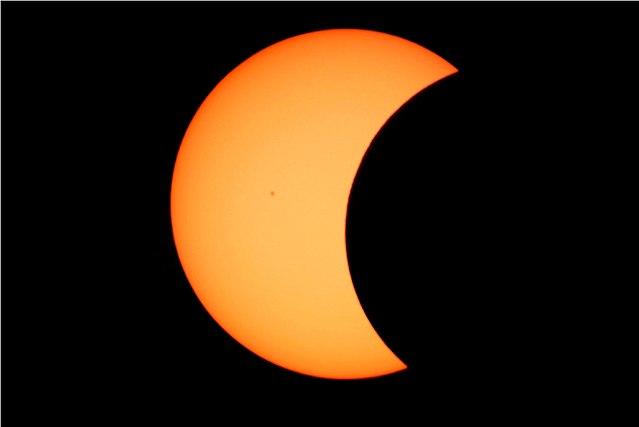Solar eclipse of February 26, 2017
An annular solar eclipse took place on February 26, 2017. A solar eclipse occurs when the Moon passes between Earth and the Sun, thereby totally or partly obscuring the image of the Sun for a viewer on Earth. An annular solar eclipse occurs when the Moon's apparent diameter is smaller than the Sun's, blocking most of the Sun's light and causing the Sun to look like an annulus (ring). An annular eclipse appears as a partial eclipse over a region of the Earth thousands of kilometres wide. Occurring only 4.7 days before perigee, the Moon's apparent diameter was larger. The moon's apparent diameter was just over 0.7% smaller than the Sun's.
Partial from Buenos Aires, Argentina
Partial from Villa Gesell, Argentina, 13:18 GMT
Coyhaique, Chile, 13:35 GMT, 1 minute before annularity
Partial from Pisco Elqui, Chile, 13:48 GMT
Solar eclipse of January 15, 2010
An annular solar eclipse occurred at the Moon's ascending node of the orbit on January 15, 2010, with a magnitude of 0.91903. A solar eclipse occurs when the Moon passes between Earth and the Sun, thereby totally or partly obscuring the image of the Sun for a viewer on Earth. An annular solar eclipse occurs when the Moon's apparent diameter is smaller than the Sun's, blocking most of the Sun's light and causing the Sun to look like an annulus (ring). An annular eclipse appears as a partial eclipse over a region of the Earth thousands of kilometres wide.
It was the longest annular solar eclipse of the millennium, and the longest until December 23, 3043, with the length of maximum eclipse of 11 minutes, 7.8 seconds, and the longest duration of 11 minutes, 10.7 seconds. This is about 4 minutes longer than total solar eclipses could ever get.
Annularity from Jinan, China
The eclipse in Bangui, Central African Republic at sunrise
The eclipse from Thiruvananthapuram, India where the eclipse was 92%
Satellite image showing the moon's antumbra falling over India and the Bay of Bengal








